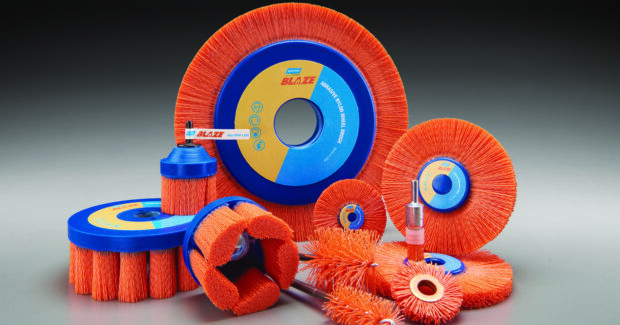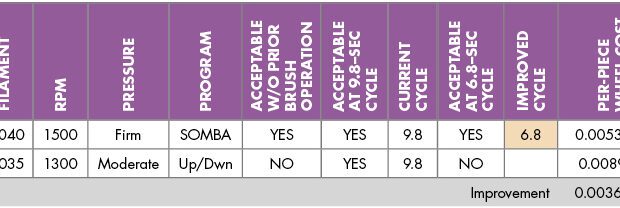Bank on Better Abrasives
A 20% increase in consumable costs reduced an automotive component supplier’s cycle time by 30% and is saving almost $250,000 annually on machine operating costs.
Posted: January 17, 2020
SURFACE CONDITIONING COLUMN
Over the last few years, automotive and aerospace manufacturing output demands have grown exponentially. Suppliers are getting more orders and, in the race to meet customer delivery and quality requirements, are scrutinizing all processes and consumables for potential productivity gains.
One element that’s often overlooked during reviews are the abrasives used during component subassembly. This isn’t surprising given how hard subassembly teams must work to ensure the supply pipeline is uninterrupted during day-to-day operations. However, when there is a noticeable increase in production requirements, the strain on all aspects of the manufacturing and delivery supply chain builds. Sometimes the challenges push systems beyond what they can handle.
You could respond by paying overtime and/or hiring more employees and, if your budget allows, buying new equipment. While these are all acceptable ways to increase production, they’re expensive and time-consuming. Robotic equipment is particularly costly and, given that the availability of high-quality automation systems is several months from the order date, especially difficult to justify unless it’s designed for a new part or process.
A much faster and more cost-effective way to get more from an operation is through intrinsic improvements to a current process. One of our customers recently implemented this approach, transforming a bottleneck into one of the factory’s most-productive operations by equipping a robot-finishing system with higher-quality abrasives. Longer brush life and greater output are paying for the brush’s greater initial cost.
Optimize Your Current Process
The manufacturer first explored the potential for increasing the productivity of its Acme Manufacturing (Auburn, MI) Fanuc-controlled robotic deburring cell.
Although functioning well to meet previous part output and quality parameters, the system was too slow to keep up with the added requirements placed upon it by increased orders. It had become a bottleneck for upstream operations that include a machining process. Overall output was being adversely affected.
Having identified the robotic system as the choke point, the company focused next on the abrasives being used and found exceptionally high downtime levels. Four narrow radial brushes that cost $46 per setup were being replaced several times a day. While the cost appeared to be an advantage, poor ability to hold the filament in the core hub and overall inability to allow for faster rpm were all disadvantages.
Their cut rate was also a problem.
Cycle time to produce two parts was nearly 10 seconds. At this rate, the manufacturer produced about 12,000 pieces per day, 40% lower than the production target. Although the cycle time rate indicated 15,000 parts were possible, changeovers related to filament durability increased downtime so much that more than 12,000 pieces could rarely be produced.
Output had to increase to at least 20,000 pieces per day to avoid buying a $1 million robot system that was expected to take 34 weeks to be delivered.
Reduce Cycle Time
We recommended equipping the setup with a better-quality-filament radial wheel brush. Although they would cost $60 per setup – 20% more than the previous brushes – Blaze ceramic alumina nylon brushes last 20% longer than aluminum oxide, silicon carbide, and other ceramic grain options and cut 20% to 30% faster.
The brush is particularly well-suited to automated applications because of the ceramic grain’s shape and distribution. The grain is elongated to increase the number of cutting points as it’s exposed and cut equally whether pressure is applied to the side or tip of the filament. The grain is also extruded with the nylon filament to increase resistance to heat and stress and form a flexible bond that enables filaments to bend without microfracturing.
For this application, we recommended the 1-inch-wide Blaze in long trim for the 4-inch outside diameter brush head. The 1.25-inch filaments provide maximum conformity on irregular surfaces.
After making some programming adjustments on the machine, cycle time fell from nearly 10 seconds to below 7 seconds. The 30% reduction enabled the manufacturer to achieve its daily production target with more than 20,000 pieces being produced using only one setup. The improved radial brush design enabled running at a slightly faster rpm with modestly firmer pressure without losing many of the abrasive filaments in the process.
Trifecta of Improvements
With the ability to get more benefits from the better abrasives, adjustments to the process could be made using the same equipment, operator, and overall process. This change resulted in over 40% more output capability and higher-quality parts while lowering the overall cost per piece.
The results were impressive:
- Cycle time reduced from 9.8 sec to 6.8 seconds
- Less brush changeovers equated to a more consistent process
- Nearly 40% less cost per piece for abrasives and better output with the same labor requirements.
To get to the same weekly output with the original process, the operations would have had to run on Saturdays and Sundays as well as weekdays. At a conservative estimate of $100 per machine hour, that would have cost the manufacturer an additional $4,800 per week — $240,000 per year – compared to implementing the new process.


















